Activities to Teach Voiced and Voiceless Sounds
This post may contain affiliate links. As an Amazon affiliate, we earn from qualifying purchases.
Get easy, engaging, research-backed ways to teach voiced and voiceless sounds! We’re sharing step-by-step guidance and hands-on activities to help your students master this concept and a FREE PRINTABLE worksheet for them to practice.
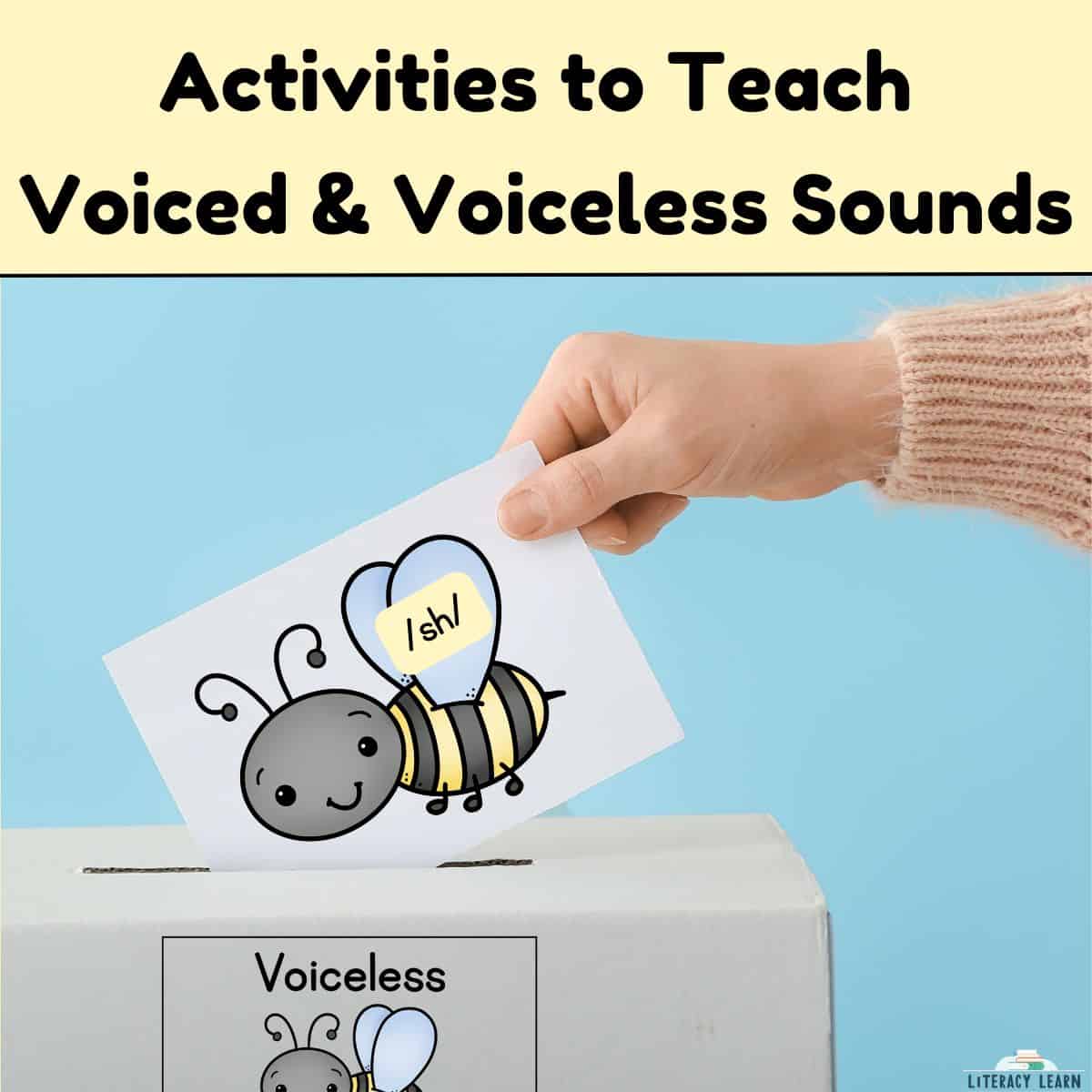
How to Teach Voiced vs. Voiceless Sounds
Teaching my students about voiced vs. voiceless sounds is one of the VERY first concepts I use when starting OG instruction with any new student I work with. That’s because it’s the foundation.
I first teach the differences between vowels and consonants and then immediately discuss voiced and voiceless sounds.
It’s not a concept that takes a long time for students to learn; in fact, its quite simple and kids pick it up very quickly.
👩🏽🏫 If you need more clarification or just want to learn more about this concept, first read our blog post to learn all about voiced and voiceless sounds. Then, come back here so you can learn how to teach them!
Voiced vs. Voiceless Lesson Plan
Here’s how I teach it to my students using the gradual release of responsibility model:
1️⃣ I DO:
Have kids sit near your classroom sound wall. Begin by introducing a consonant pair, like /z/ and /s/. Explain that these sounds are made the same way in the mouth, but /z/ is voiced (the voice box is on) and /s/ is voiceless (the voice box is off).
Say both sounds clearly and model the mouth position. Have students place their hand on their throat to feel the vibration for /zzzzzzz/ and the lack of vibration for /sssssss/. (I like starting with continuous sounds so kids can hold them out for as long as they have breath and really feel the vibration/lack of vibration on their voice box.)
Clearly define the terms voiced sound and voiceless (or unvoiced) sounds: “Voiced sounds use your voice box. Voiceless sounds don’t.”
Explain how we “test the sound” to see if its voiced or voiceless. Model how to place a hand on their throat to feel if their voice box is turned on (vibrating) or off (not vibrating) and make the sound. If they feel a vibration, it’s a voiced sound. If they don’t, it’s a voiceless sound.
Model “testing” a few voiced/voiceless sounds like /p/, /m/, /k/, and /j/. Explain that consonant sounds can be either voiced or voiceless.
Then move to the vowel valley and model “testing” a few vowel sounds. You can choose any sounds; it really won’t matter because all vowel sounds are voiced
Teach that consonant sounds can be voiced OR voiceless and vowel sounds are always voiced.
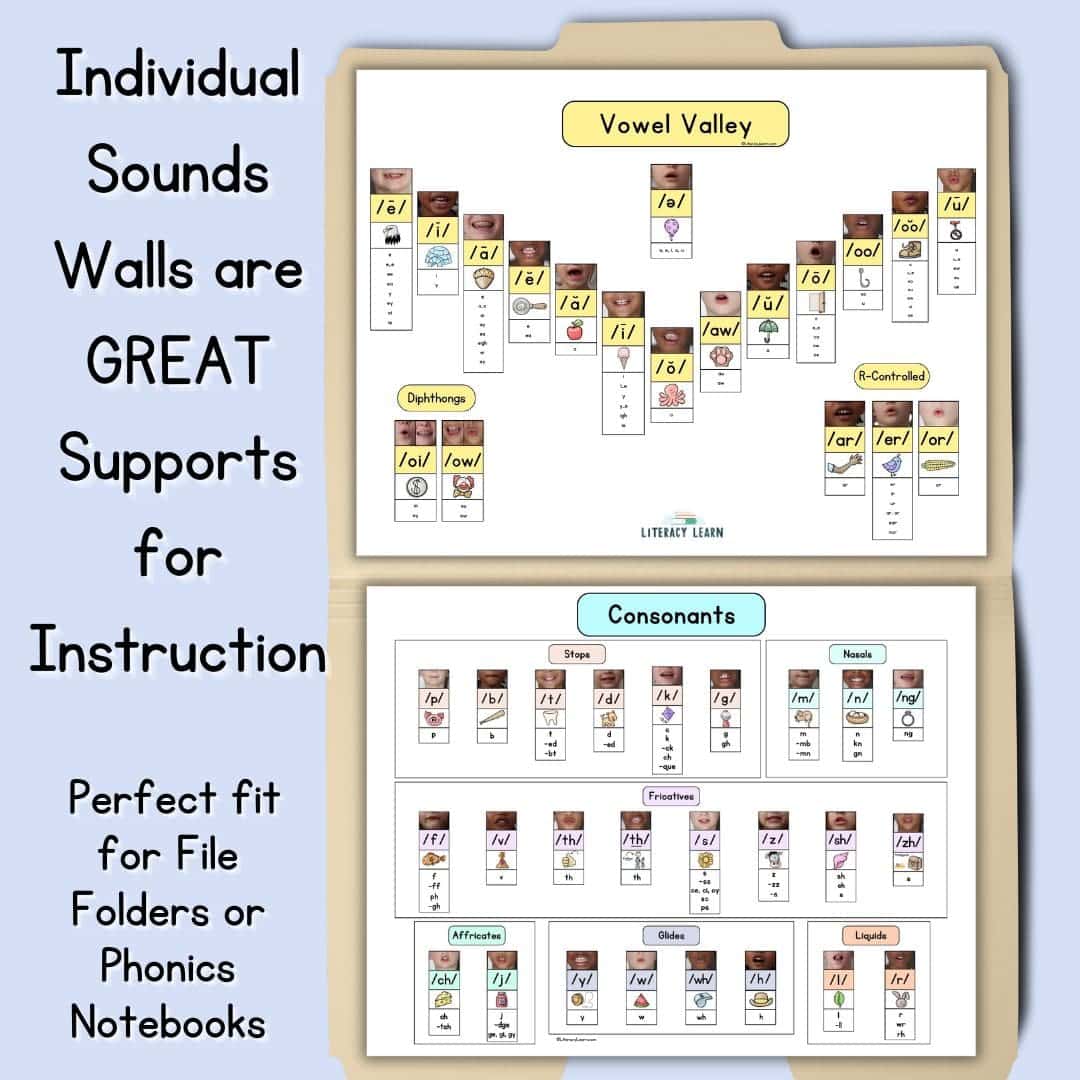
2️⃣ We DO:
Give each student a mirror. Introduce another consonant pair, such as /v/ and /f/. Have students look in the mirror as they say /vvvvvv/ sound, then feel their throat to identify if it’s voiced or voiceless. Discuss. Then repeat with the /ffffff/ sound.
Repeat this procedure with other pairs, providing support, guidance, and scaffolding.
- /g/ & /k/
- /d/ & /t/
- /b/ & /p/
- /zh/ (as in treasure) & /sh/
- /th/ (as in the) & /th/ (as in thin)
3️⃣ YOU DO TOGETHER:
Have students practice together. List a few sounds on the board, and encourage students to test each sound by feeling their voice box to test the sounds to determine whether the sounds are voiced or voiceless.
They should discuss with a partner and write a list on a t-chart with columns titled voiced & voiceless.
Now students are ready to practice independently using a few fun activities listed below!
Activities for Voiced vs. Unvoiced Sounds
Below, we’ve outlined a few fun activities for teaching voiced vs. unvoiced sounds.
Get the FREE worksheet at the bottom of this page, and learn other ways to help students practice and master this concept.
🌟 The good news: We have ALL of the activities below ready for you to use! Read about them and then grab ALL of the voiced and voiceless activities we describe below on TPT or as an Unlimited member (plus more)!
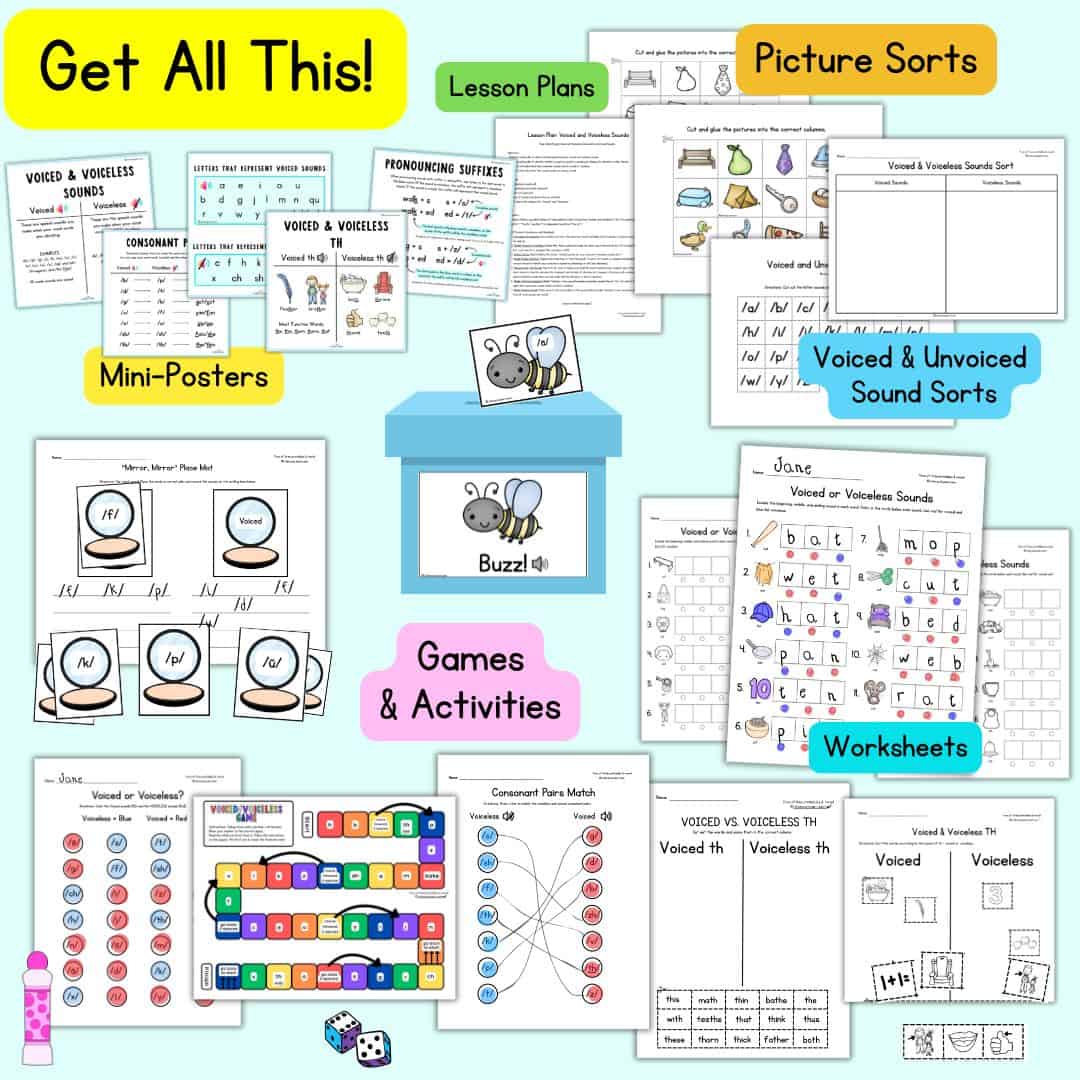
Voiced vs. Unvoiced Sound Sorts
This activity helps students develop a deeper understanding of phonemes by distinguishing between voiced and unvoiced sounds—an important aspect of phonemic awareness and articulation.
There are two versions of the sort included:
- Sound Symbol Sort
Students cut out sound cards that feature phonemes written between virgules (slashes), such as /b/ or /p/. These cards are sorted under two headings: voiced and unvoiced. Because the focus is on sounds, not letters, this reinforces the concept that speech sounds and written symbols are not always the same—strengthening the alphabetic principle. - Picture-Based Sound Sort
Students look at the initial sound of each pictured word and sort it based on whether the beginning phoneme is voiced or unvoiced. This version requires phoneme segmentation, giving students essential practice with isolating and identifying individual sounds—one of the most critical skills in phonemic awareness instruction.

Both activities are hands-on and support auditory discrimination, which is foundational for decoding and spelling success.
Mirror, Mirror, on the Wall
This hands-on activity helps students explore voiced and unvoiced consonant sounds by using a mirror. It allows students to physically feel and see how sounds are made.
Materials Needed:
- Phoneme Cards
- Place Mat for Sorting
- Individual handheld mirrors
- Optional: Access to your classroom sound wall
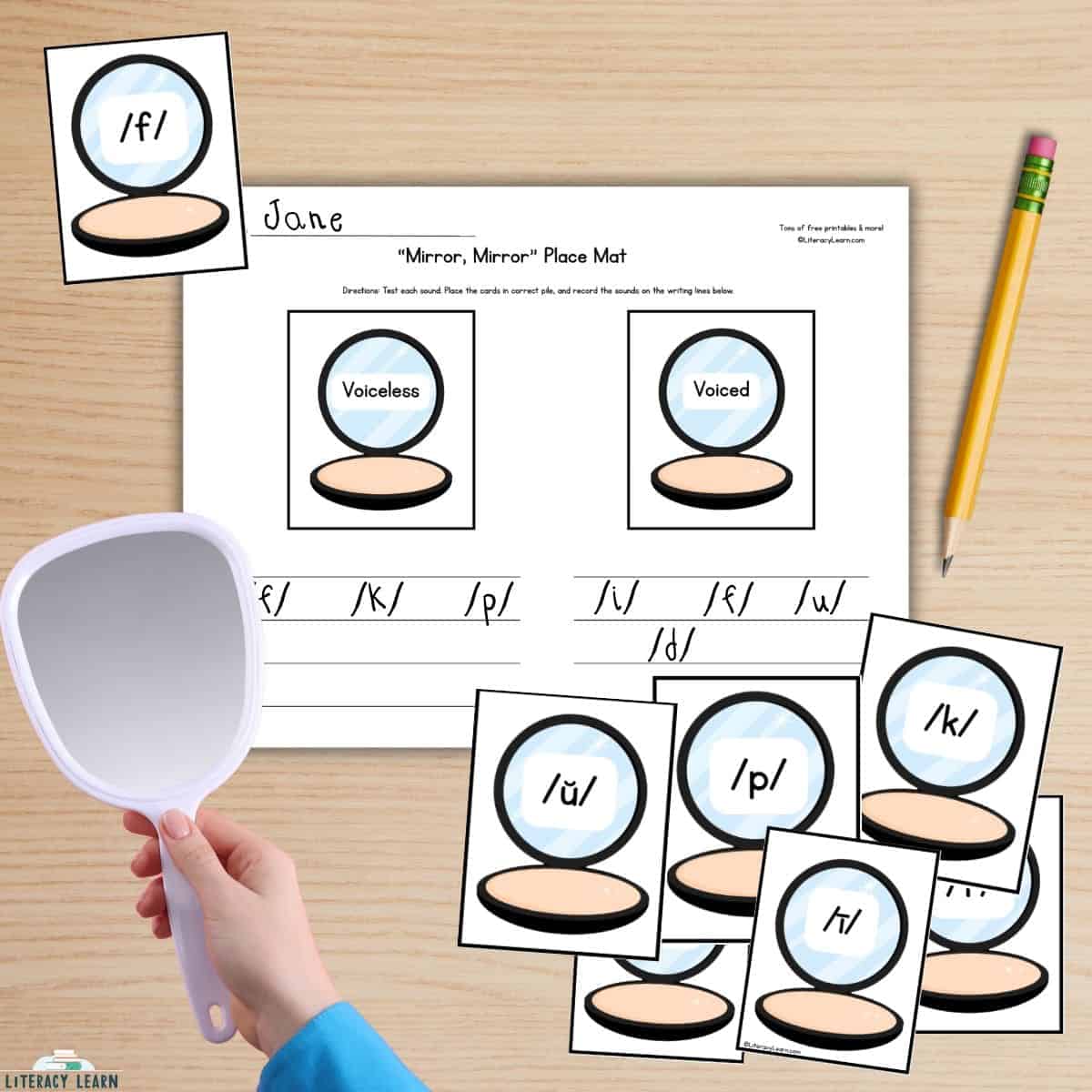
How to Play:
- Set the Stage: Give each student a mirror and explain that they’ll be using it to see and feel how sounds are made. Shuffle the mirror cards.
- Say a Sound: Students pick up one mirror phoneme cards at a time. Mirror cards each include one target sound (e.g., /t/, /d/, /s/, /z/) and students should say it aloud.
- Mirror Check: Students repeat the sound while:
- Looking in the mirror to observe mouth placement and movement
- Gently placing a hand on their throat to feel for vibration (voiced) or no vibration (voiceless)
- Sort & Match: Students then use the place mat to identify where that sound belongs. They should:
- Decide if it’s voiced or unvoiced.
- Place the card in the correct pile (voiced or voiceless)
- Record the sound on the writing lines.
Why It Works:
This activity builds metacognitive awareness of how speech sounds are produced. It engages multiple senses—visual, auditory, and tactile—and connects phonemic awareness to the concrete structure of the sound wall.
It’s especially powerful for helping students with articulation and spelling!
👉🏽 Get our Sound Wall with real and diverse mouth articulation photos.
Buzz or No Buzz Game
Objective: Students will listen to or say a target sound and decide whether it is voiced (buzz) or unvoiced (no buzz).
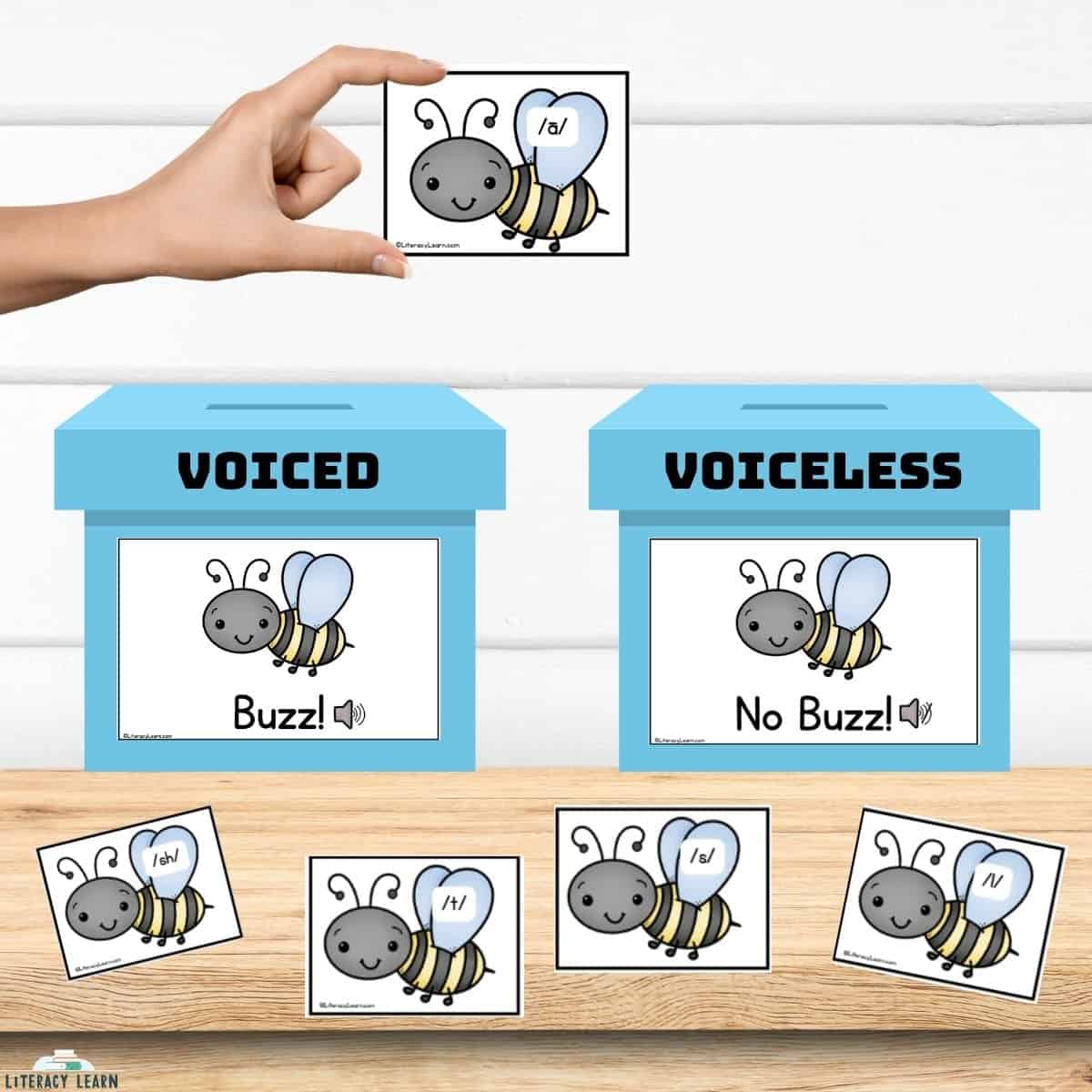
Materials Needed:
- A set of bee/buzz phoneme cards
- Two labeled containers or sides of a whiteboard:
- One labeled Buzz! (for voiced sounds)
- One labeled No Buzz! (for unvoiced sounds)
How to Play:
- One student draws a card and says the sound aloud.
- All students do a quick vibration check by placing their hand on their throat to feel if their voice box buzzes.
- The group decides together: Is it a Buzz or No Buzz sound?
- The sound is sorted into the correct category.
- Bonus points can be awarded if students can come up with a word with the same beginning sound.
Extension:
Turn it into a relay race. Divide the class into two teams. Students take turns drawing a sound, saying it, and racing to place it in the correct “buzz” or “no buzz” bin.
FREEBIE: Voiced or Unvoiced? A Phoneme Isolation Activity
In this activity, students practice isolating individual phonemes and identifying whether each sound in a word is voiced or voiceless. This goes beyond basic sound recognition—students must segment each word into beginning, middle, and ending sounds. The task strengthens phonemic awareness and promotes orthographic mapping.
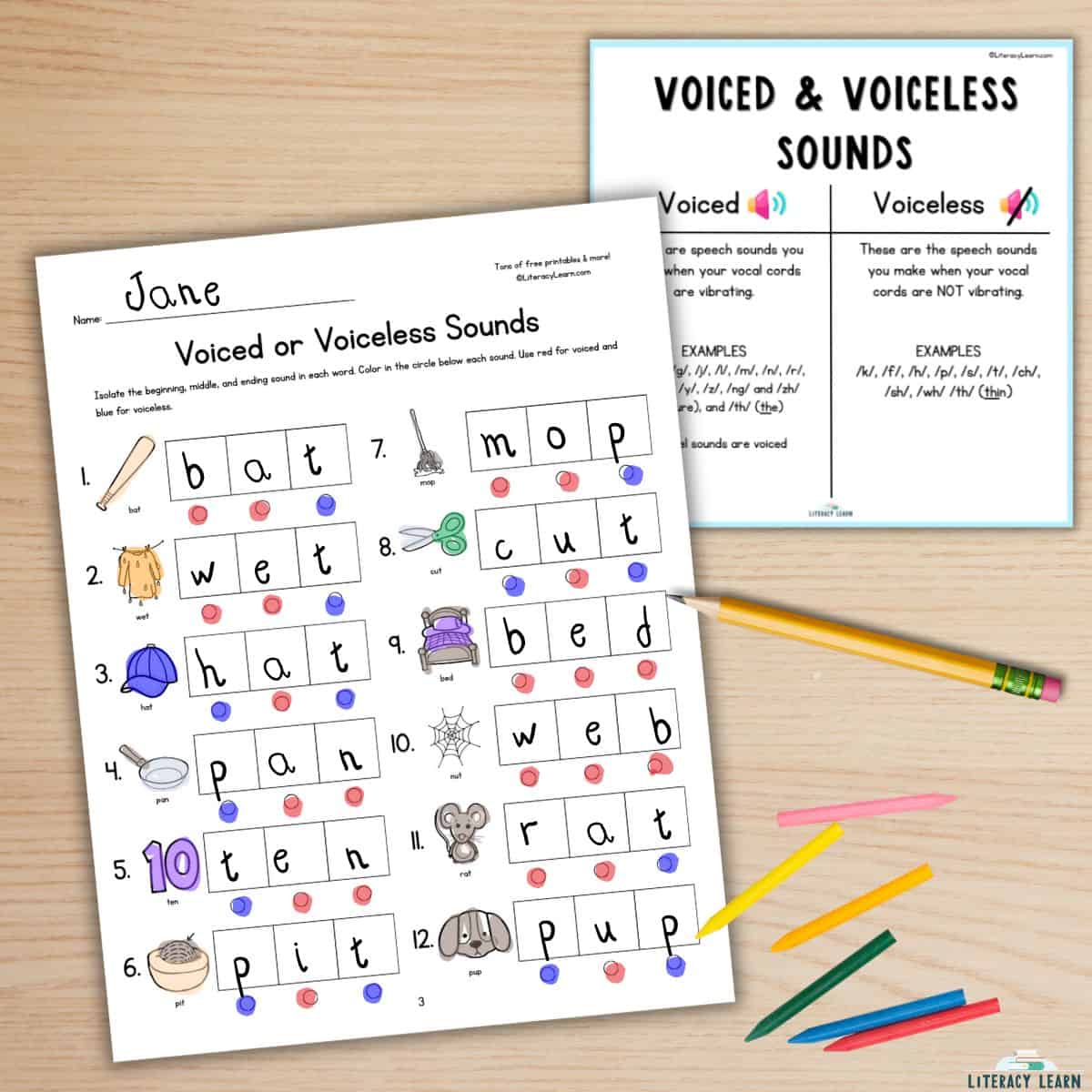
How to Use:
- Download and print the worksheet.
- Read and Identify Sounds – Students will look at the pictures and say each word aloud.
- Segment and Match Sound – Using elkonin boxes, students will isolate each phoneme and match it to the correct grapheme.
- Determine Voicing – For each sound, students will decide if it is voiced or voiceless. They’ll then color the corresponding dot below each sound: blue for voiceless & red for voiced.
This activity is ideal for students who are ready for more advanced phonemic awareness work. It supports segmenting skills. Plus, it provides a meaningful way to bridge phonemic awareness and phonics instruction.
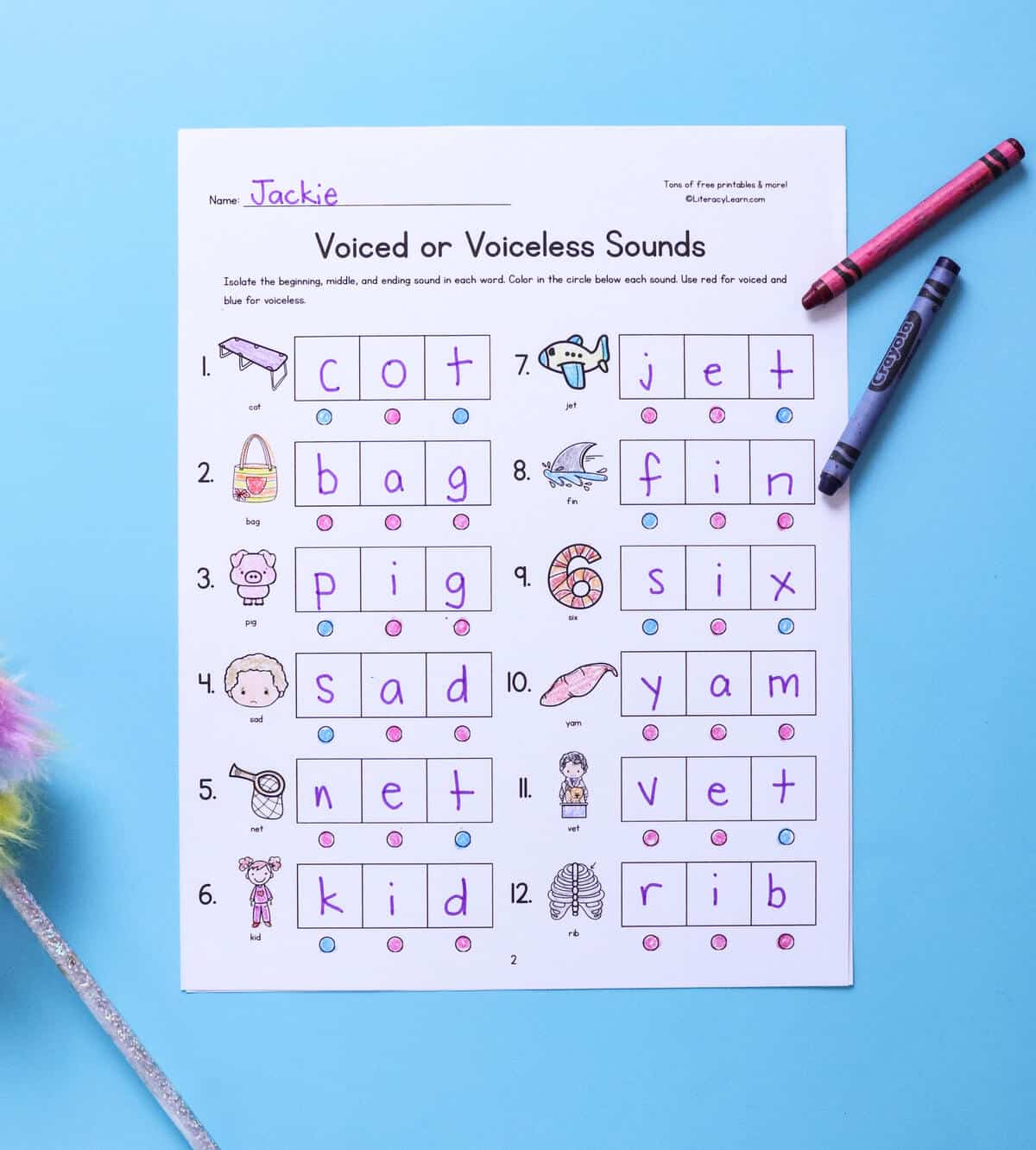
More Print & Go Activities
Do you like the ideas above and want to get these activities, ready at your fingertips? Look no further than our Voiced and Voiceless Sounds product in our TPT store or as an LL Unlimited member.
You’ll get…
- Voiced vs. Voiceless sorting worksheets (pictures and sound/symbol)
- Cut-and-paste and circle-the-sound activities
- Practice with consonant pairs
- Voiced/Voiceless TH activities
- Games & Center Activities
- Posters & Visuals
- Black-and-white & color printables for easy use
- Lesson plan and activity descriptions
Conclusion
Understanding and teaching the difference between voiced and voiceless sounds is a foundational step in helping students become confident, skilled readers and spellers.
With explicit instruction, multisensory tools, and fun, hands-on activities, your students will quickly grasp the concept.
Whether you’re just getting started with OG instruction or looking to reinforce phonemic awareness, these strategies will set your students up for success.
Download & Print
DOWNLOAD TERMS: All of our resources and printables are designed for personal use only in homes and classrooms. Each teacher must download his or her own copy. You may not: Save our files to a shared drive, reproduce our resources on the web, or make photocopies for anyone besides your own students. To share with others, please use the social share links provided or distribute the link to the blog post so others can download their own copies. Your support in this allows us to keep making free resources for everyone! Please see our Creative Credits page for information about the licensed clipart we use. If you have any questions or concerns regarding our terms, please email us. Thank you!
More FREEBIES: Voiced & Voiceless TH worksheet, 44 Phonemes Chart

